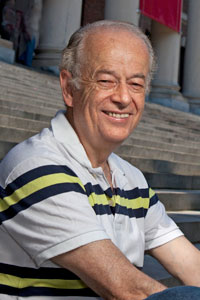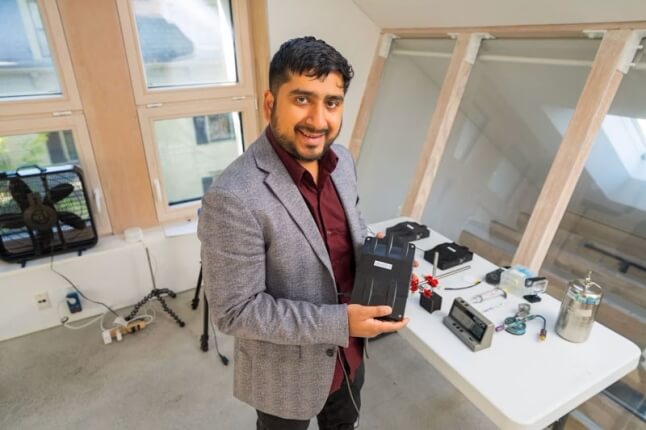News
Federico Capasso is Robert L. Wallace Professor of Applied Physics and Vinton Hayes Senior Research Fellow in Electrical Engineering. (Photo by Eliza Grinnell, SEAS Communications.)
The following is an excerpt from an article by Peter H. Siegel, published in IEEE Transactions on Terahertz Science and Technology in January 2013. It is one in a series of profiles of distinguished researchers which are intended, according to Siegel, "as a tribute to individuals who have contributed significantly, and over many years, to the terahertz community, and as a guide and inspiration for those who are just beginning their professional association with this field of study."
Federico Capasso credits his father, an economist and businessman, for nourishing his early interest in science, and his mother for making sure he stuck it out, despite some tough moments. However, he confesses his real attraction to science came from a well read children’s book—Our Friend the Atom, which he received at the age of 7, and recalls fondly to this day. I read it myself, but it did not do me nearly as much good as it seems to have done for Federico!
Capasso grew up in Rome, Italy, and appropriately studied Latin and Greek in his pre-university days. He recalls that his father wisely insisted that he and his sister become fluent in English at an early age, noting that this would be a more important opportunity builder in later years. In the 1950s and early 1960s, Capasso remembers that for his family of friends at least, physics was the king of sciences in Italy. There was a strong push into nuclear energy, and Italy had a revered first son in Enrico Fermi. When Capasso enrolled at University of Rome in 1969, it was with the intent of becoming a nuclear physicist.
The first two years were extremely difficult. University of Rome had very high standards—there were at least three faculty members who had personally worked with Fermi—and teaching did not include much hand holding. When he began his thesis work with Francesco De Martini, a distinguished researcher in nonlinear optics who had worked with Charles Townes at MIT, he was told simply “Take this blueprint, build a ruby laser and see me in six months.” Remarkably, when he came back with a working laser, De Martini sent him back to the lab with the assignment, “Now build a heat exchanger for our argon laser.” Despite a strong desire to let De Martini hear what he really felt about this request, he went back to the engineering shop and designed an oversized cooler that not only worked on the argon laser, but many other more powerful lasers in the lab, thus endearing him to his fellow researchers.
As already mentioned, the university crossing was not one that Capasso easily traversed. The 22 successive oral and written exams, lack of grade inflation and rigorous course load, had Capasso rethinking his career choice after two years. Here his mother came to the rescue, and insisted that he keep struggling while banishing all thoughts about quitting. In his third year, things finally began to click, and ultimately he came out of University of Rome with several nice papers, and a focus in nonlinear optics, rather than nuclear physics.
Perhaps this somewhat painful, although ultimately triumphant start in science, along with a very hierarchical academic system in Italy, contributed to Capasso’s decision to go into industry after completing his degree. After a short Post-Doctoral appointment, he took up a permanent position as a research physicist at Fondazione Bordoni in Rome, starting in 1974. Fondazione Bordoni was one of a number of government institutions around Europe that specialized in communications, and as such, these were commonly referred to as “Post-Office Laboratories.” Capasso started working on optical transmission, including amplifiers liquid core fibers and mode theory.
Despite the appeal of a secure permanent position at Bordoni, Capasso was restless and longed for an opportunity to go abroad. The US was especially attractive, and after marrying his wife of 37 years, Paola, in 1976, he applied for and received a Rotary Fellowship that supported him to work in a research institution outside of Italy for nine months. However, the terms of the fellowship were that the Award Committee chose the laboratory, taking into account the applicant’s skills, as well as his preferences. Capasso’s fluency in English was turning out not to be the gift his father had wished, as the committee was about to send him to Belfast, Northern Ireland, at a time when this particular city would not have been the first choice of a Catholic man with a new young wife. After an appeal, the Rotary Fellowship was instead applied to an alternate English speaking country—the USA—to a very desired slot at Bell Laboratories. Relieved, Capasso and his wife gleefully set out for Holmdel, NJ, USA, in the fall of 1976....
Read the entire article in IEEE Transactions
Topics: Applied Physics
Cutting-edge science delivered direct to your inbox.
Join the Harvard SEAS mailing list.
Scientist Profiles
Federico Capasso
Robert L. Wallace Professor of Applied Physics and Vinton Hayes Senior Research Fellow in Electrical Engineering




